Benjamin Pothier/Hervé Studio, Trailer M.A.A.R.S. Atacama’s Journey
The Atacama desert in Chile is one of the harshest environments on Earth. It is so dry that the central sector can go through periods of up to four years without any rainfall. As for the land, it is so arid, so deprived of water and nutrients that it is almost sterile. Yet, the desert harbours the world’s largest supply of Sodium Nitrate, a well-known fertilizer. The area seems to be as intriguing as it is inhospitable. It’s in the Atacama desert that the oldest artificially mummified human remains have been found. And while most cultures around the world primarily preserved the dead elite, the Chinchorro performed mummification on all members of their society. But the reason why i mention this extraordinary desert today is because it is one of our closest analogues for Martian surface conditions.
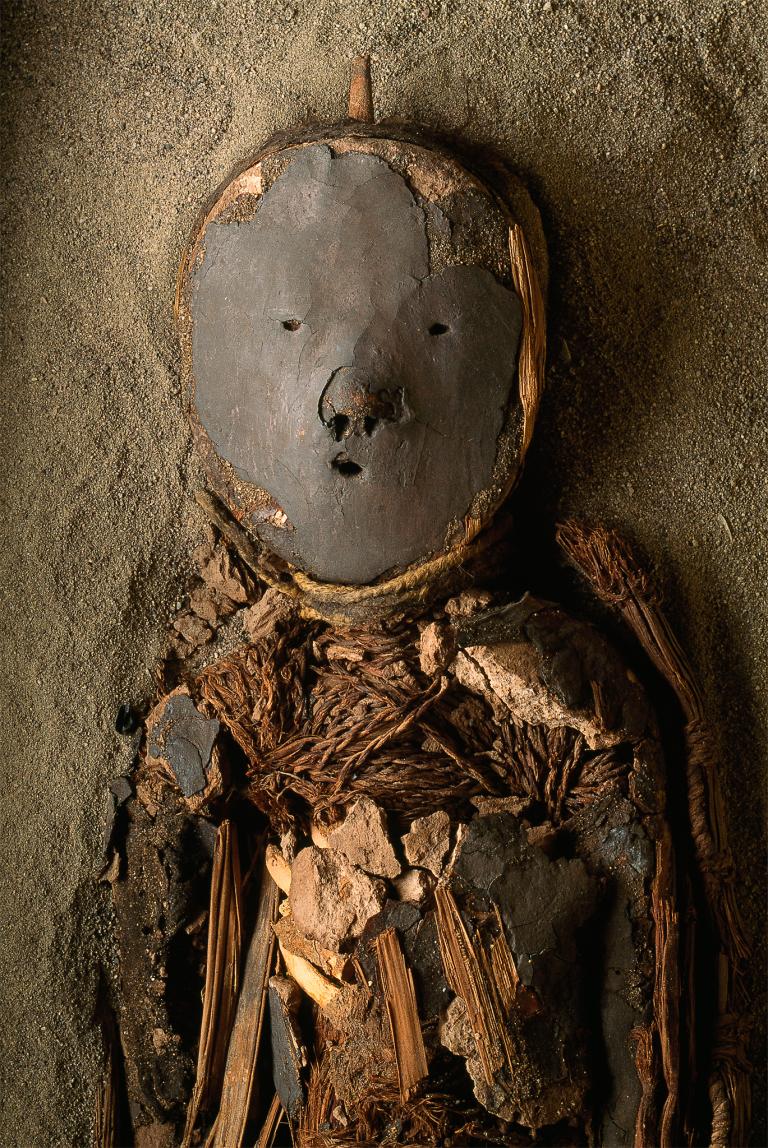
The paste-faced head of a Chinchorro child mummy is held straight by a stick that emerges from the top of the skull. Photo: Enrico Ferorelli, National Geographic
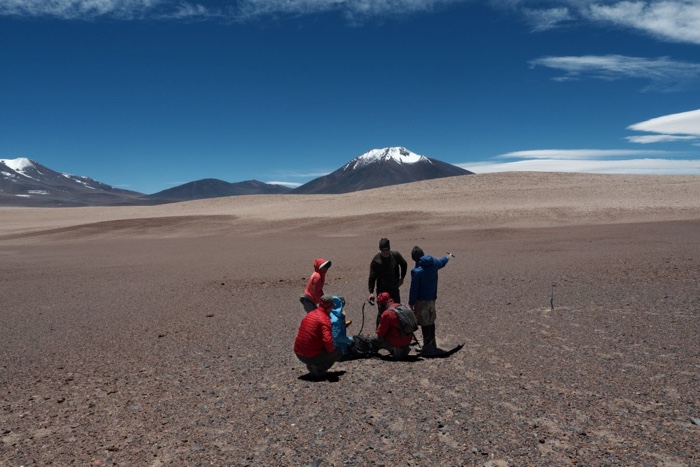
Science In The Wild [MAARS] Mars Atacama Research & Simulation expedition. Photo by Benjamin Pothier
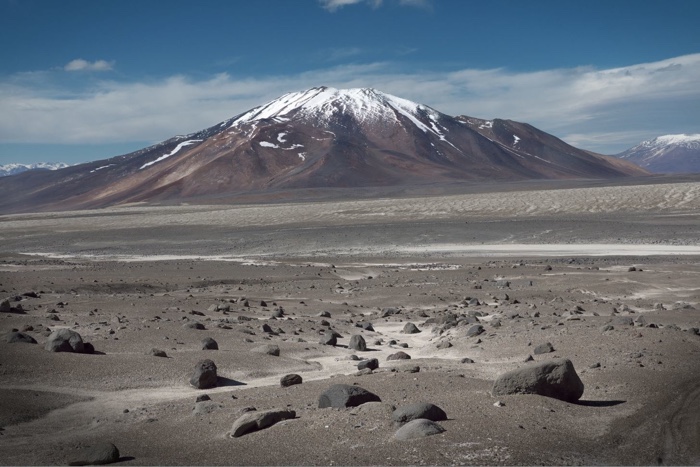
Science In The Wild [MAARS] Mars Atacama Research & Simulation expedition. Photo by Benjamin Pothier
Benjamin Pother, an artist, anthropologist and PhD Candidate in the Planetary Collegium research group at Plymouth university recently joined a team of scientists and explorers including astronaut candidates for an expedition to the Atacama desert and a hike to the Ojos Del Salado Volcano, a nearby active volcano that boasts the highest lake in the world.
The 15 day trip, called M.A.A.R.S which stands for Mars Atacama Analog Research & Simulation, offered the group the opportunity to conduct a range of experiences and measurements for scientific purposed and future space missions, including the test of Astronauts Gloves (gloves are, it seems, one of the main engineering challenges of space missions.)
Pothier documented the Atacama journey in a short video that not only reveals amazing landscapes but aso touches upon issues such as survival in hostile environments.
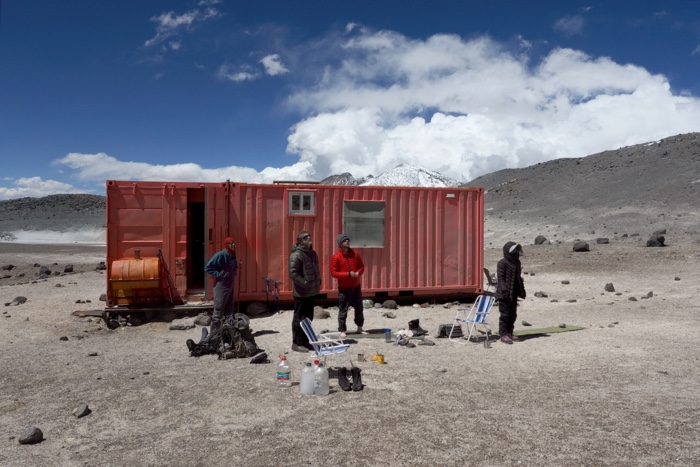
Refuge #3 at 5837 meters, Atacama. Photo: Benjamin Pothier
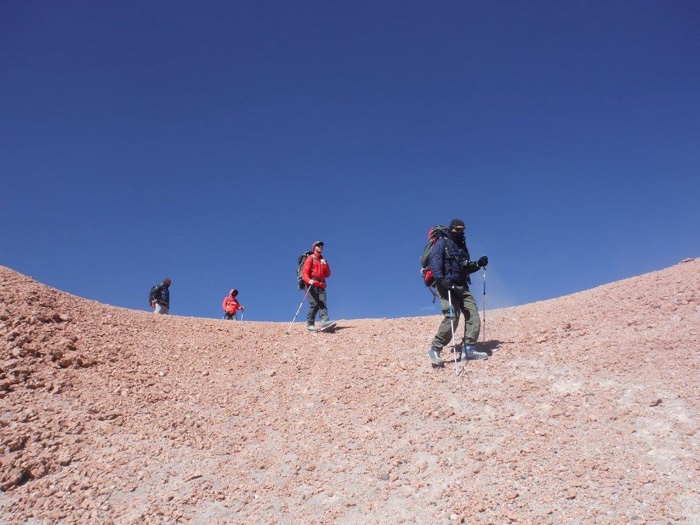
Atacama team during an approach. Photo: Thomas Edunk
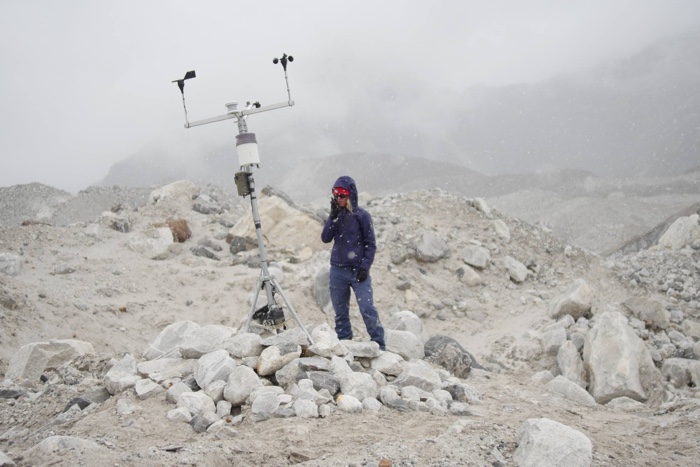
Dr. Horodyskyj repairing a weather station at 4800 meters, Himalayas. Photo: Benjamin Pothier
Hi Ben! Is the possibility of actually living on Mars a plausible one? I thought we’d only send robots to mine for us there?
Well, as far as I know there are still many challenges to overcome before any human will be able to first go to Mars (and come back safely) .
I was recently invited to deliver a talk about my experience of participation to Art expeditions in extreme environments and a Mars Analog astronaut training, at the Earth without Humans II symposium. It was co-organized by Kapelica Gallery, the European Space Agency and Ars Electronica.
Earth without humans II / Zemlja brez ljudi II (there’s also a longer video summing up the event)
During the Symposium I got the opportunity to learn more about future Mars Missions, as other speakers included researchers from NASA and the European Space Agency ESA , as well as the Artists/Architects Marko Peljhan and Barbara Imhof. Marko is one of the founder of the visionary Makrolab project, an autonomous habitat and art/architecture/technology project developed in the early 90s that has been deployed at documenta in Kassel, the Venice Biennale, etc. but also in the Arctic and other extreme environments. Barbara is what we have to call a “Space Architect”. Within her studio LIQUIFER SYSTEMS GROUP, she has developed self-deployable habitat for extreme environments and a large number of other space related architecture projects (some being funded by ESA or the European Union ), and to come back to Mars, she designed the LAVAHIVE proposal for a modular habitat on Mars using available Mars soil, that was awarded the 3rd prize for a NASA 3D printed habitat competition in 2015.
So if humans are actually going to live on Mars one day, it might definitely look a little bit like this at the beginning.
Currently, some of the challenges include the duration of the flight, and the needed payload to send to Mars, including tonnes of food and supplies for the astronauts ready to go on this first mission (astronauts on space shuttle missions and flights to the International Space Station currently get 3.8 pounds (1.7 kilograms) of food per day). Not to mention the exposure to cosmic rays that definitely have an impact on human physiology, especially during a mission that will last at least around 21 months which also brings psychological challenges for the future crew. But you are right that in the very near future it’s still robots that are going to be sent to actually mine the Martian soil, for the first time (as far as we know).
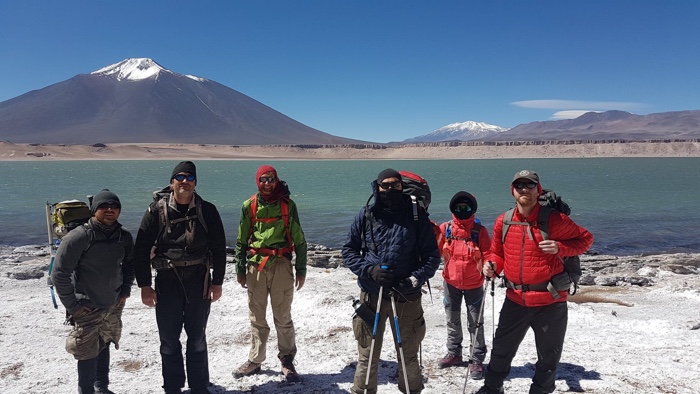
Part of the M.A.A.R.S team (left to right): Thomas Edunk, Jason Reimuller, Chris Lundeen, Benjamin Pothier, Etsuko Shimabukuro, Casey Stedman. © Sebastian Gonzalez Martin
What do you personally think about the possibility of living on planet Mars. Would you be tempted to travel there? To me, going there sounds like the most punishing adventure conceivable. i’ve always thought that Martian settlers would be like the convicts who were sent to Australia. Have you learnt anything during the expedition and research that could make a trip to Mars a bit more alluring?
For the question of the possibility of actually living on Mars, I have no doubt that there is nowadays a conjunction of political, scientific and economic (and cultural) forces that are working together, or at least in the same direction, to make this possible in the future. I don’t think we can compare it to the time, back in the 1950s, when people were imagining flying cars, if you know what I mean. I think there is really a very strong possibility that it will happen.
Then, on a personal level. And to be very honest, I definitely don’t project myself in the future going to Mars. But, you know, when I was younger I never thought I would go one day at 20 degrees from the North Pole in the Arctic Ocean, visit the northernmost human settlement on Earth, nor join an international group of astronaut candidates up to 5837 meters high on the world’s highest active volcano on the driest desert on Earth. But I actually did.
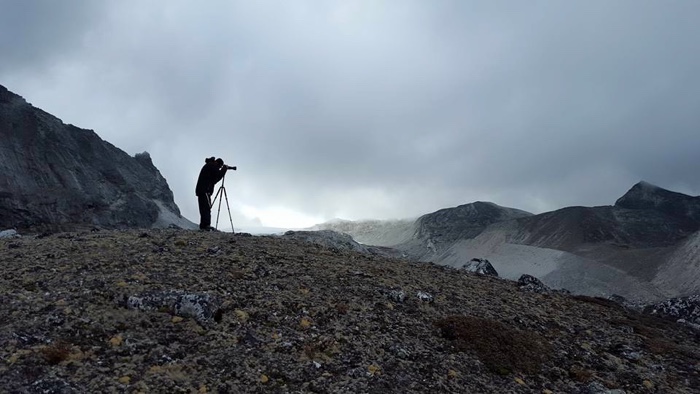
Benjamin Pothier working near the Tibetan border 5300-meters, 2016. Photo by DR. Horodyskyj
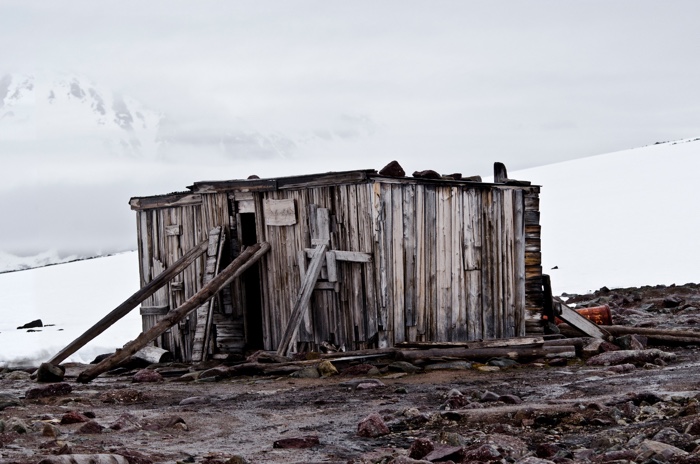
20 degree from Northpole Svalbard. Photo: Benjamin Pothier
However for Mars, it’s first very very unlikely that anybody would think “hey! let’s invite that “crazy” artist-researcher for the trip, he is apparently very good at vegan cooking, that could be useful!” Hahaha! But more seriously, even if I had the opportunity I would definitely not go, it’s not for me something that I “couldn’t refuse”. Even though I am very interested in the technologies, processes and strategies that are being developed to go there one day.
But, and it’s more a comment of the evolution of space technologies and its accessibility, than of any of my, let’s say personal and professional skills to actually be able to do it or be selected to do it. At the moment I really and honestly don’t plan nor “dream” to go to Space, or even at the very border of Space, nor on the Moon… but I wouldn’t say that it can’t happen in the future. I am nowadays much more aware of the requirements to actually “go to Space”, in terms of training and skills. And if I’m lucky enough to live 50 more years, I think Space is going to be something much more accessible in the not too distant future. For scientific, economic and technological reasons.
Then, to be clear, because of my various practices, these days I know more and more people and I have friends and colleagues like the artist-astronaut Dr Sarah Jane Pell who are very much likely than me to go to Space in the quite near future (Hi Sarah!) Anyway there are various plans being set for Mars at the moment from MARS ONE (I don’t know if it’s in standby or not) to NASA Projects. Insider tip, it seems quite clear through the discussions I had and research I made that we have good chances to see first a permanent or semi-permanent settlement on the Moon. I think they will need to test on the Moon various habitat concepts. It sounds like a very reasonable projection. I am definitively less convinced by the one way scenarios.
But to make the trip more alluring, according to some of the last research you might be able to have some fresh vegetables on the menu on Mars and during the flight, mostly tomatoes, rye, radish, pea, leek, spinach, garden rocket, cress, quinoa and chives … and strawberries !
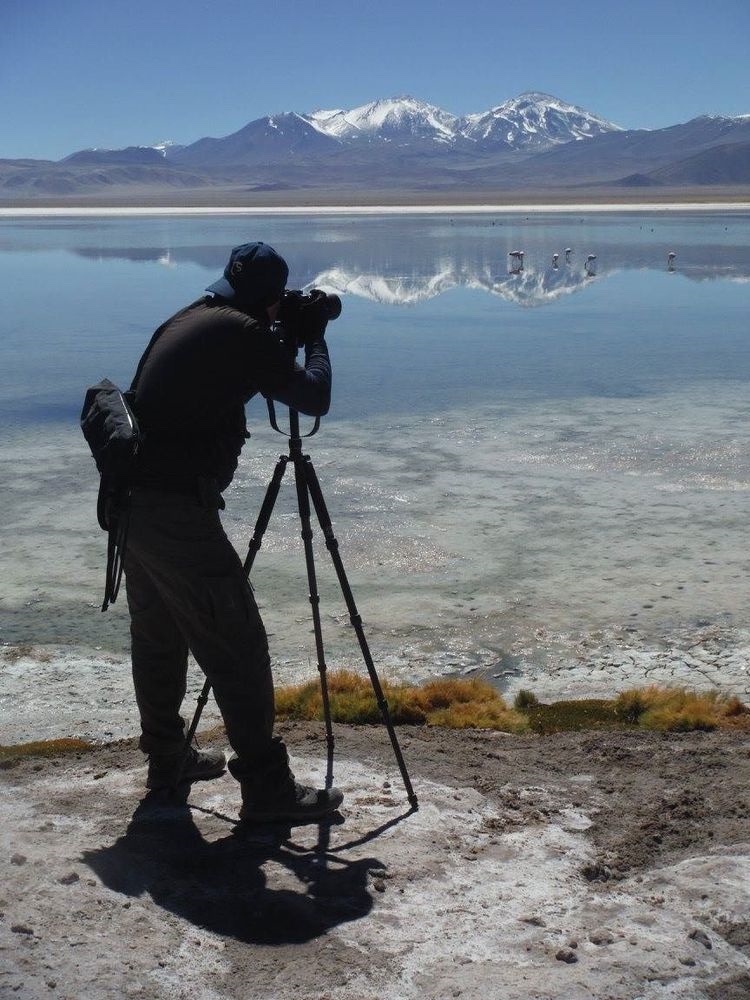
Photo by Thomas Edunk
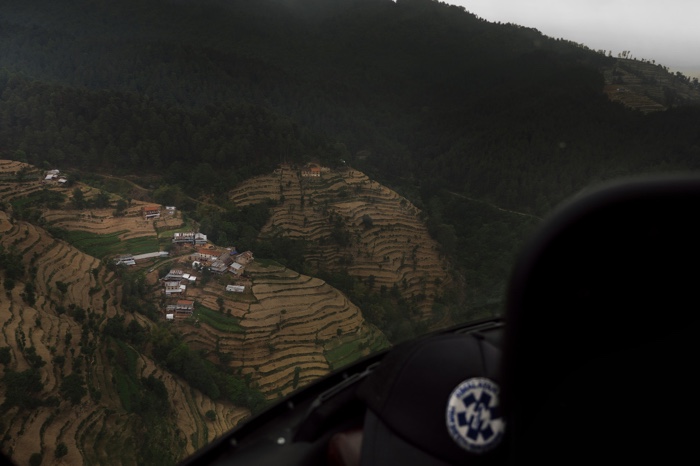
Helicopter view on the way to Lukla‘s airport. Photo: Benjamin Pothier
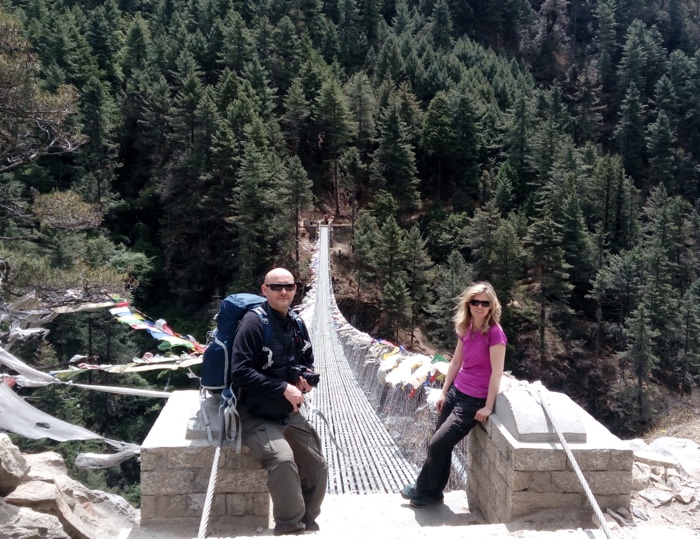
Crossing a bridge in the Hymalayas with Dr. Horodysky
How do you complement each other and manage to help and support one another over the course of these expeditions?
For the question of being supportive to each other, when we were in the Atacama desert quite recently. The driest desert on Earth, and the environment the most similar to Mars in terms of geology on our planet. I had the opportunity to spend a lot of time in various “extreme” situations with some astronaut candidates. We spent around 15 days in the Atacama. One of the candidate was Etsuko Shimabukuro. A Japanese lady with an amazing life path and a very good level of physical training. She has been selected for the MARS ONE program. I don’t know if this program will happen or not, but anyway they plan to send people for a one way trip to MARS, no coming back….
And you could feel that Etsuko is definitively ready for a one way mission, physically and psychologically. And I really respected her preparedness, mindset , whatever you can call it. A very Zen-like mental state in fact. And I think the first way to support others is to show confidence through your own behavior. To teach by example.
Same with many other members of the team. I enjoyed discussions and daily life during this experience with Casey Stedman, an Air Force pilot and astronaut candidate with a record of previous participation to NASA isolation & simulation missions. He also participated to one HI-SEAS mission that many people in the art community know because Angelo Vermeulen, who is as much an artist as a researcher, was the team leader of one of those long duration simulation of Mars habitat near a Volcano in Hawai. And like Etsuko, Casey also had his own ways of behaving, coming from his various training and pasts experiences, as well as from his personable character. And I totally respected and I think understood his understanding of group cohesiveness.
During the expedition I think we also supported each other by sometimes taking care of each over. Like when, at an unexpected moment, someone pops up some chocolate from his pocket to share with the team. When you are in the middle of nowhere, it’s freezing outside and there is a sand storm…
People are there because they have an adventurous mind, and they have been selected because they have a quite decent physical training, and we mostly all deeply enjoyed every day to be part of this. A truly unique experience. And there was a lot of jokes and very unique moments and discussions. But still you have to act with a sense of responsibility, because any problem that can happen on those remote locations could very quickly turn into a disaster. Some of my colleagues have lost friends or guides in the past. Some have been themselves the victims of 10 or 100 meters non-lethal “falls”, that still leave you with bruises and broken ribs, and slight PTSD… And by a sign of destiny I wasn’t at the Everest Base Camp the day an earthquake struck Nepal in 2015. It’s too long to explain this here, but I was supposed to be there the day the avalanche almost completely destroyed the Everest Base Camp. So all of this makes you think twice about what’s important in life, I guess…
It’s a balance between thinking about your own safety, being part of the group, and more or less constantly checking the person next to you. It was as much daily basic questions like asking your team mate if he took his Diamox that you need to take in order to adapt to very high altitude, or being sure that nobody is dehydrated, or if someone start to act “strangely” , because high altitude can also have psychological impacts. And I guess astronauts on the ISS have some very similar procedures. To an awesome discussion I had with Chris Lundeen, the project Coordinator of the Project PoSSUM, during our push climb to the highest point I went on Ojos Del Salado, the refuge #3 at 5837 meters. It’s always easier to say it after the trip, and we all had some down at a point, but being laid-back in stressful situations is usually a proof of professionalism.
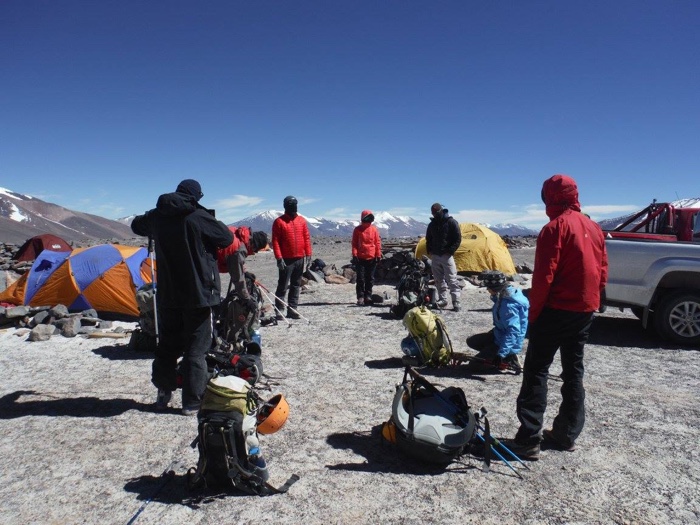
Team Atacama at camp 2, 5300 meters. Photo: Thomas Edunk
Which kind of strategies for survival have you developed/used in Atacama that could be applied to Mars?
I would say that most are psychological, then of course we now have an experience of one of the few geological terrain on Earth that are very similar to a Martian landscape. What I tend to develop personally is the ability to act as a film maker even during those hard experiences, meaning to use cameras and lenses and other gears very precisely so you don’t break anything and provide as much awesome shots as you can. I’ve done that from the high Arctic to the Atacama desert. But in fact it’s a mindset that can be applied to the use of any technical equipment during any demanding experience, be it life on Mars or in Antarctica. It relies mostly on the concept of “drill”.
And as I mentioned previously, the “survival strategy” I tend to develop on the psychological side is more a collaborative one than the over competitive one. I have been part of rock bands and artists collective in my past, and even played basketball teams. So I tend to have that approach to group cohesiveness, a team, one goal, winning together, to say it short. But at the same time, as an artist I tend to develop a strong personal view on most of things, and I usually tend to question authority… So I think it’s a kind of balance that would also be necessary for life on Mars.
I see it more like a Free Jazz Band than a special forces squad approach to group collaboration, probably. Or maybe a subtle mix of both, even though in my artist’s life I’ve met Special Force members who were very cool, and Free Jazz musicians who acted like perfect egotistic morons, hahaha! Life is full of paradoxes, you know… But more seriously…there is this notion of super skilled and at the same time very autonomous people, who also work together on something. Strong training and a sense of improvisation. You find it in Free Jazz. And nothing can beat good Free Jazz.
Then you have the experience of high altitude, which is mandatory in astronaut training because you have to train for hypoxia, the lack of oxygen that can happen in case of depressurisation of your space habitat or ship. Astronauts train in hyperbaric chambers in order to have an experience of enduring this lack of oxygen that very high altitude climbers experience at their own level. Then, even if I slightly injured myself on the last trip, my training in aikido and dance and my study of human movement and performance was definitely useful to go through the physical challenge that it was. Mostly endurance. Knowing how to properly use your body so you will not break your back, all those things.
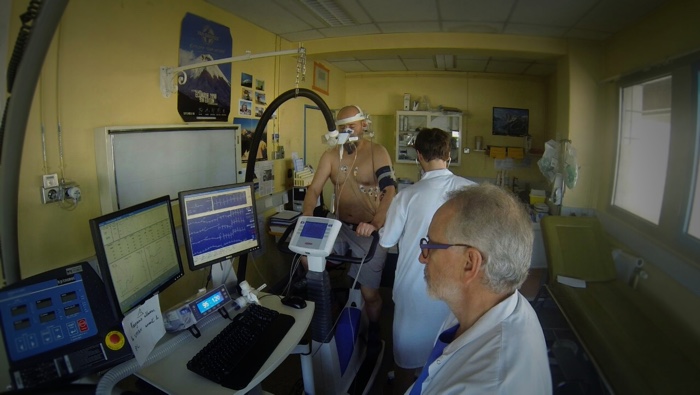
High Altitude Hypoxia testing with professor Richalet
How do you train to climb to such high altitude? i read you almost lost your right eye while you were there?
First, as I said previously you have to prepare for hypoxia. In order to do so I passed tests with the professor Richalet a Paris-based world-renowned specialist in very high altitude and extreme performances. I virtually biked on top of Mount Blanc, the highest French mountain, with sensors on my body and a regulation of the level of oxygen I was receiving during effort. For the last four expeditions I also trained physically, including 30 minutes to one hour daily physical training and 7 hours walk with around 13 kilos of equipment in a rocky forest near Paris.
And even though I’ve been pretty lucky for the previous expeditions I indeed injured myself a little bit in Atacama. Basically a blood vessel exploded in my right eye the second time we climbed up to 5837 meters high, which is my own record at this point. Probably because of the sudden effort on the last part of the trail, and of course the altitude itself. Anyway I’m back and safe with no sequels… Don’t forget that I am an artist first, not a professional alpinist. I’m amazed to have been able to go up to 5837 meters already.
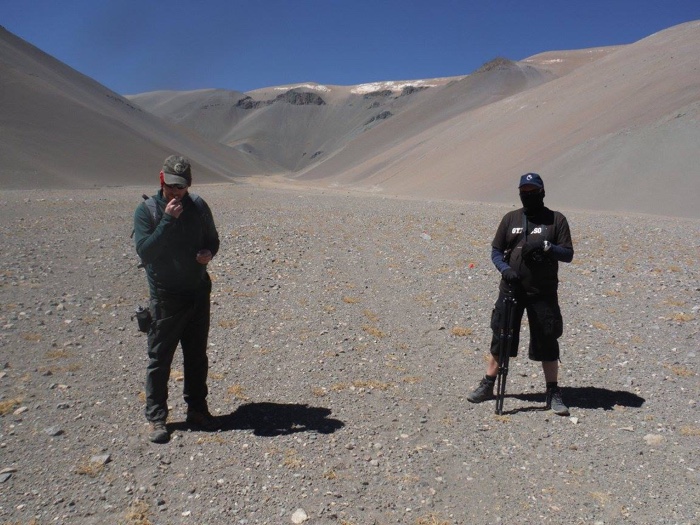
With Casey Stedman in the Atacama
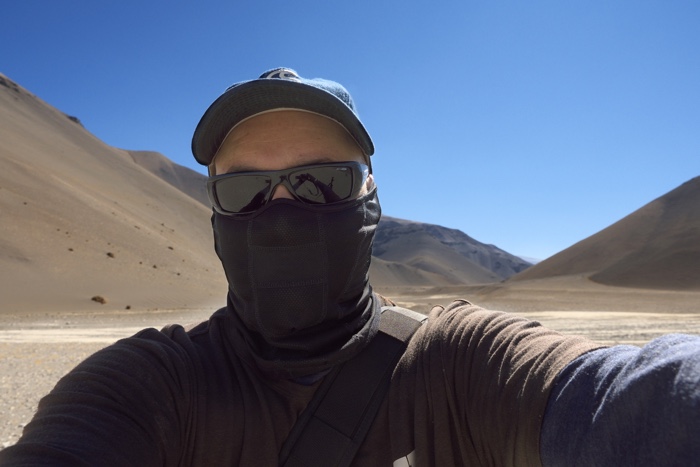
Selfie in the Atacama desert. Photo: Benjamin Pothier
The trailer of MAARS mentions the fact that what mankind will have to do is adapt to Mars instead of replicate the conditions we have on earth. Could you give us some examples?
Sure, getting back to the work of Barbara Imhof for example. Challenges of building proper habitats on Mars. To Provide oxygen, water and food to the crew, construct a durable habitat. Then of course you will have a sort of new kind of humanity, living on a closed system with life support. Barbara through LIQUIFER partners with 12 other European research institutions and companies in the development of the EDEN-ISS project. Future Mars inhabitants will need to have food production, that’s why amongst other research project about growing food in Space, this one will be tested over the course of one year, at the German Neumayer III station in Antarctica. Of course it’s exciting as is, but also for another reason.
The Space race was responsible for innovations and inventions that are now part of our daily life, living on the ground, on Earth. Be it the computer mouse, freeze-dried food or the mobile phone. And I have no doubt that some of the research that are deployed nowadays in order to prepare a possible life on Mars in the future will have some impacts on our daily life on Earth. And hopefully some will be useful for the upcoming challenges that are brought by climate change and the anthropocene at large.
So of course for Mars it will be technical and psychological adaptation to a closed environment with life support. I’m quite certain that the crew will have Daily Tasking Orders (DTOs), like the ones on the ISS (International Space Station), meaning a very clear schedule of daily tasks for each crew member. But considering the duration of the mission I guess psychologists working for NASA or ESA are doing some research on this. Anyway, life in a Zen monastery, on the ISS or in submarines, prove that humans can adapt to a very precise daily schedule for long duration.
We had that discussion with the Team in Atacama during a workshop on Space exploration lead by Jason Reimuller, the Director of the PoSSUM program. A very surrealist moment that I remember very well. We were near the Salt lake of Laguna Verde at an altitude of 4300 meters, in a small wooden shelter made of scrap materials, with heavy winds outside, almost sand storm, not the one you would face on Mars, but still very heavy, and we discussed space exploration, EVA suits, astronauts anecdotes and team building. All of this in this shelter that looked like a mix of a Mountain cabin, a Hobo handmade shelter and maybe even a contemporary art installation or sculpture. A D.I.Y shelter. Very Vernacular.
Everybody agreed that for long term missions you need more than engineers, scientists and pilots. You need arts, culture, you need a creative cook that will protect the crew from boredom. You need a group narrative. And you could use science in order to prepare all of this, but pro tip : “you’ll need an artist” .
What can your artistic perspective on anthropology and extreme environment bring to the research on space travel? What is your role during this type of expedition? I suppose that it is not limited to documenting the adventures?
Well, I’ve grown up an interest in Space Art since the early 90 ies, following the work of Marko Peljhan, Ewen Chardronnet and so on, I was also a lot into Astronomy in my teenage years, participating to observation workshops in the mountains in France. And of course my deep interest into Sci-Fi since my young age, first through literature then through movies, made me aware of all those topics. I definitely don’t consider myself a performer, but after 15 years of Aikido and studying and practicing contemporary dance for more than 8 years, through the supervision of world renowned choreographers like Josef Nadj, I think I can tell one or two things about human movement and extreme performance. This brought me for example to publish a peer reviewed paper dealing with the questions of human movements in zero gravity environment in Technoetic Arts Journal.
More specifically for the expeditions, I am also now a trained civilian first aid responder level one both alone and in team (two different diplomas and training). As an artist I am usually more used than researchers to collaborate with companies, meaning that I’ve provided in the past solar power solutions, up to date two ways radios or satellite terminal to the expeditions, that I used for daily blogging for newspapers and magazines, but that were also useful as backup tools and ressource for the researchers, or testing techwear garments like NASA Aerogel hardshells and other kind of cool prototypes. There is also something reassuring for people to be “part of a documentary process” during an expedition. I tend to think that I also bring something more subtle and hard to define which is related to the mystery of artistic creation itself…
To my surprise most of the people on our Atacama Mission had that kind of artistic sensibility at some levels. I’m also kind of specialized in the study of hunters and gatherers tribes, for my anthropological research, and it seems to fit with the small team expeditions mindset.
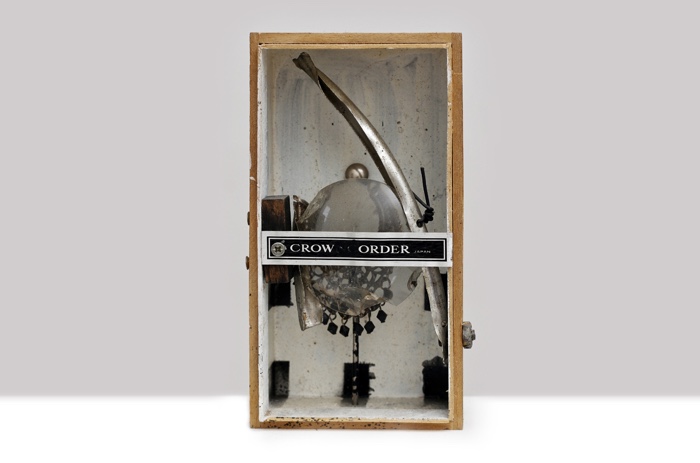
Benjamin Pothier, Crow Order (Found materials)
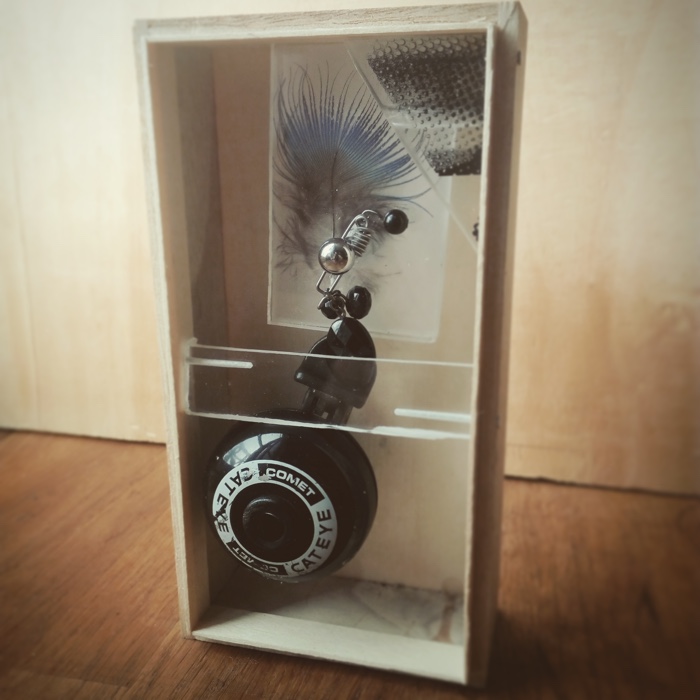
Benjamin Pothier, Comet (Found materials)
And on the other hand, what do these expeditions bring to the way you approach your artistic work?
The first teaching of those type of expedition is to put you in a state and situation where you just can’t give up, because at some point if you stop walking for example, you are simply going to die frozen in the mountains. A very direct Zen teaching! hahaha! And as an artist working on even a simple sculpture can look sometimes like an insurmountable mountain… I tend to be more laid-back facing obstacles, even if I have my ups and downs, like anybody. But I don’t give up on the long run, something like this, and extreme expeditions teach you that. The good old hard way… it teaches you resilience.
Then travelling is a way to encounter new cultures and civilizations at a certain level. Maybe I’m wrong but I think that most artists have a kind of internal visual library of forms, shapes, that comes from their knowledge of art history, through books and exhibitions, but the very vernacular mountain shelter made with scrap materials that’s currently influencing the look and shape of my next sculpture, well, I had to walk 15 days up to 4800 meters in the Himalayas to see it… And it’s probably because I didn’t have time to make so much photos of it. That its shape and “vibration” (let’s try not to be too much “new-Age” , hahaha…) is resurfacing in a new work. And I’m talking about an art work, a sculpture, not an attempt to make a 1/100 scale architectural model of the shelter. Beyond film and photography , I have a regular practice of sculpture with found and upcycled materials, and of course I bring back objects from my travels that I integrate in those sculptures…
I’m also sure that the colors I saw for example in Nepal, from people’s clothing to painted buildings or spices in shops, or specific gears related to climbing, will have an influence in the coming years on my work production. But for me it’s a very slow, almost organic, process to integrate new influences of this kind.
Finally on a technical level, I have acquired a fairly good expertise on rugged, waterproof, dust proof, etc. And ultra portable technical solutions for autonomous film making ,sound recording and photography (and self survival) on the harshest environments on Earth, from cameras to portable solar power solutions and telecommunication devices, and this has definitely an impact on the way I can imagine the future of my artistic practice. This lead me to be hired recently as a film director by The Crowd and the Cloud, a US production company, during my first expedition in the Himalayas, I directed the Himalayan sequence of a four part documentary that was broadcasted on PBS this year:
The Crowd & The Cloud, Sherpa Science
And it’s probably also one of the reasons why Herve.io co-produced my latest project, including a 360 film shot during the Astronaut training in the Atacama.
And we will show the project for the first time during the Balance-Unbalance 2017 conference in Plymouth (UK) from August 20th to 24th
All of those experiences and my interest in techwear even lead me to collaborate closely with a very technical bag brand from Berlin, BAGJACK, which is almost mythical in the techwear scene (Even William Gibson is a hardcore fan…) And we developed together a bag prototype for my expeditions, based on an existing model but with some new featured that I designed. We plan to release a very limited series of those bags, and for me it’s definitely at the border of design and art. I hope to collaborate more closely with innovative brands in the future in order to develop those kind of super cool hybrid projects.
I was reading an interview of you in which you explained: “I’m working with an artist based in the Netherlands who is doing space art and we are going to send a photograph from the Mars Curiosity Rover test site to the moon through a radio telescope, and then, another radio telescope on earth is going to receive the image.” Could you give us more details about that?
Sure, amongst other colleagues I already knew, I had the chance to meet for the first time Daniela De Paulis, an amazing artist based in the Netherlands, at the last Computer Arts Conference in Paris. We discussed about her work and I discovered that she was actually the artist who developed a very innovative Space Art project that I knew already through the various contemporary art “scenes”. She has worked on this technology in collaboration with the radio amateur community and people from Dwingeloo radiotelescope in the Netherlands.
To quote her official statement :
(…) a live radio transmission performance between the earth and the moon. During the live show the digital images of the seven colours of the spectrum are sent as sound signals to the moon from a radio station located in Brazil, the UK or Switzerland and received back from Dwingeloo radio telescope in The Netherlands. The performance also includes a live video connection with radio amateurs based at Dwingeloo radio telescope.
(…) Communication Moon Relay was a military project by the U.S Navy using the technology ‘Moonbounce’, also called Earth-Moon-Earth. This is a radio communications technique developed shortly after WWII which allows sending radio signals to the Moon and receive them back as reflection. Communication Moon Relay grew out of many ideas and concepts in radio espionage. Some impetus for the project was provided by the post-war efforts to develop methods of tracking radio signals, particularly those originating in Eastern Europe and the Soviet Union.
So basically this technology will let us send to the Moon and back images as radio waves. And through that technique we will send a photograph I took of the Atacama desert landscape, a landscape so similar to Mars that the NASA tested the Mars Curiosity Rover there before sending it to Mars… So you will have a photograph of a Mars simulation test site, taken during a Mars Analog simulation mission , going to Space and back to Earth.
And there will be alterations and glitches on the image that will come back, because the surface of the Moon isn’t smooth, it’s not flat. I’m sure it will be quite cool visually, but I also find it very exciting mentally. The way I see it , it’s a kind of “Baudrillardian” Space Art. And you know, that’s typically the kind of projects I like to engage into… I’m not a headbanger, but to quote one of my colleagues at the Planetary Collegium, “I like heavy mental” … hahaha….
I would like to thank my family for their support all along those years. The Dr Ulyana Horodyskyj and the PoSSUM Team, as well as the other members of our Team, including Thomas Edunk who was my very cool team mate in the Atacama expedition and who provided some of the expedition photographs.
Thanks Ben!
For an overview of one of Benjamin Pothier‘s previous adventures, check out: Because i always wondered what an artistic residency in the Arctic might be like…
